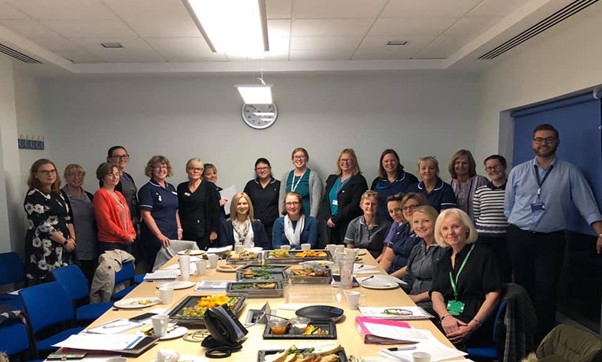The next blog from our series on knowledge mobilisation comes from Dr Andrew Finney, Senior Lecturer of Nursing at Keele University. This blog introduces the use of Critically Appraised Topics (CATs) in community nursing.
 Dr Andrew Finney is a Senior Lecturer at Keele University’s School’s of Nursing and Midwifery, and Medicine. Andrew holds the title of ‘Queen’s Nurse’ and as a nurse academic he is a mixed methodologist with a specialised expertise in nurse-led interventions. Andrew has extensive experience of trial methodology, epidemiology and qualitative exploration. His research has focussed predominately on primary care nursing. Andrew has led the Keele CAT group for primary care nurses since 2015 and is now scaling it out nationally as a model of research engagement for nurses that supports the Chief Nursing Officers Strategic Plan for Research (2021).
Dr Andrew Finney is a Senior Lecturer at Keele University’s School’s of Nursing and Midwifery, and Medicine. Andrew holds the title of ‘Queen’s Nurse’ and as a nurse academic he is a mixed methodologist with a specialised expertise in nurse-led interventions. Andrew has extensive experience of trial methodology, epidemiology and qualitative exploration. His research has focussed predominately on primary care nursing. Andrew has led the Keele CAT group for primary care nurses since 2015 and is now scaling it out nationally as a model of research engagement for nurses that supports the Chief Nursing Officers Strategic Plan for Research (2021).
I think we can safely say that on the whole, nurses shy away from research. More often than not we tolerated research lectures when we trained, and we have done post-registration research modules only when we’ve had to! It feels like it is someone else’s role…’the role of ‘the researcher’, not the nurse!
However, when we discuss evidence-based practice, or evidence-based nursing, nurses do naturally engage with research, as there is a sense of ownership, it means something, it means that we know that what we do is correct, current, and is hopefully ‘best practice’. If you ask nurses whether they are aware of clinical variation in what they do or if there is clinical uncertainty about some areas of practice, then nurses are actually hugely aware of lots of research questions with this focus.
One way to bring nurses to the forefront of new research is support them to identify research questions and to engage them in the search, critique and implementation processes of best evidence via the use of the critically appraised topic (CAT). CATs provide a summary of the best available evidence to answer a clinical question 1
A CAT is derived from a specific patient situation or problem and therefore has direct relevance to nurses who may have previously felt that the concepts of EBP were far removed from day-to-day clinical practice 2. A CAT aims to present research in a way that is accessible and allows nurses to read and adopt the findings in order to influence their practice.
So how does it work?
At Keele University we focussed on General Practice Nursing (GPN) and invited all local (North Staffordshire and Stoke-on-Trent) GPNs and Advanced Nurse Practitioners (ANPs) to form a CAT group. The group would be hosted by Keele University in partnership with the then Clinical Commissioning Groups (CCGs). The concept of a CAT group was put to the GPNs and ANPs and our group was formed.
We knew that the group needed an academic lead and the support of Keele’s Health library, but most of all, it needed nurses. The questions needed to be driven by the nurses. The CAT group meets every three months in an evening (in the nurse’s own time). The CAT Question(s) for that meeting are agreed and shaped for the EBP process.
The approach
Once an issue is identified within the group an answerable clinical question is shaped. The question uses a P.I.C.O framework (Population or Patient; Intervention; Comparison; Outcome) to identify search terms. A search strategy is formulated and undertaken by the universities Health Library to identify the best available evidence. The evidence is then appraised for validity and clinical usefulness by the group using recognised appraisal tools, in order to produce a clinical bottom line (CBL). A CBL is a short summary of findings that forms part of a 2-sided report of the question, results and clinical meaning, that is valuable and easy to read for clinicians. The final CAT report is published on a dedicated web page
(https://www.keele.ac.uk/iau/evidenceintopracticegroups/practicenursing/CAT). Dependent on the findings consideration is then given to the adoption and implementation of the new evidence in practice.

Example CAT question:
‘In patients that are vitamin B12 deficient is oral vitamin B12 supplementation as effective as intramuscular (IM) B12 injection?’
Clinical Bottom Line:
Administration of vitamin B12 via IM injection is common, however the results of this literature review suggested that oral vitamin B12 may be as effective as IM for some patients. Use of oral B12 may reduce practice nurse time and is less invasive than IM treatment.
Implications for Practice:
In view of the COVID-19 pandemic, high numbers of patients were able to be prescribed oral vitamin B12 in place of IM vitamin B12 with the agreement and caveats of the medicines optimisation team, reducing patient footfall through practices with no consequences to patients. Patients with Pernicious Anaemia, Crohn’s Disease or with a gastric bypass would remain on IM vitamin B12.
Group Impact:
Academically, our nurses have fully engaged with the research process. GPNs have developed their research awareness and skills through ‘bitesize’ teaching sessions aligned to the methods used within the sourced evidence. Our nurses are confident to question their own practice and that of others and have made many improvements to primary care nursing practice.
This CAT methodology is easy to transfer and replicate. CAT groups can be used for a specific discipline (i.e GPNs) or a specific condition (heart disease, diabetes etc).
The author of this Blog can be contacted should you wish to develop your own group. a.finney@keele.ac.uk
References
- Finney et al (2016) Critically Appraised Topics (CATs): A method of integrating best evidence into general practice nursing. Practice Nurse, March 2016, 32-34
- Foster et al (2001) Critically Appraised Topics (CATs): one method of facilitating evidence-based practice in physiotherapy. Physiotherapy, 87 (4), 179-190.